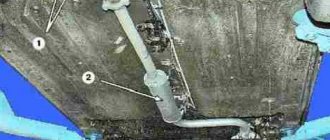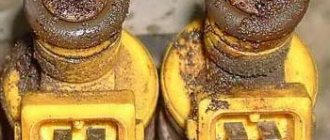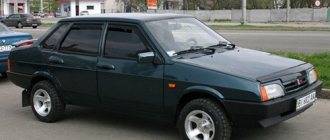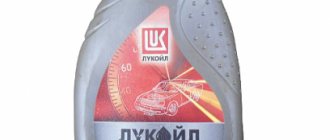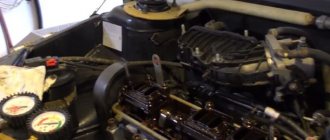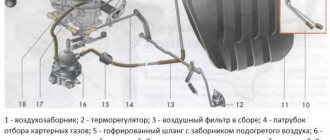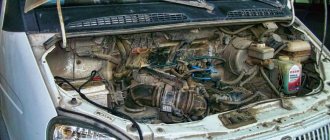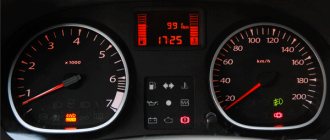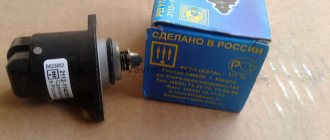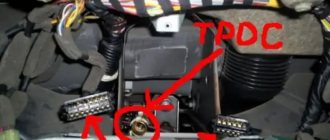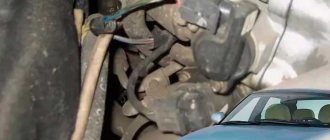Causes of “shots”, “pops” and flashes in the carburetor
- High voltage cables are not connected correctly. In this case, the spark will not occur during compression, but on other strokes, since the sequence of operation of the engine cylinders is not followed. It happens that the engine appears periodically. In this case, the solution to the problem is to reinstall the wires from the spark plugs into the distributor cover. You need to start from the installation mark counterclockwise in the following order: 1-3-4-2.
- Late ignition. Late ignition is when the spark jumps too late on the compression stroke, and combustion of the working mixture occurs throughout the entire power stroke, and not during compression. When the intake valves open, the fuel mixture is still burning and ignites a new portion.
- Faulty ignition distributor. This problem can lead to problems with the operation of the motor in all modes. It also happens that “shooting” is provoked by weak fastening of the holder. Here it is important to understand the cause of the problem in time, and also replace the distributor with a new and working one.
- The problem is in the ignition system switch. In this case, you just need to replace the switch with a new one. Repairing it is pointless and expensive; it is better to buy a new one and install it.
- The timing belt has moved 1-2 teeth. Often this problem occurs when changing the motor. The solution requires reinstalling the timing belt. This can be done if you follow the instructions, but it is better, of course, to seek help from specialists.
- Lean fuel system. If such a system enters the engine, then flashes and sparks are natural. The solution to the problem is to check the fuel fluid in the float chamber. You also need to check the cleanliness of the air and fuel jets. You can also clean the carburetor with a special solution. If the problem persists, you need to check whether the accelerator pump is working properly.
- The intake valve is burnt out. If the plate is not pressed well against the valve, sparks will appear. It is quite possible that it burned out or sagged over time. Using a compression gauge you can identify the malfunction. If there is a problem, you need to remove the cylinder head and replace it with a new one.
- Small recesses in the valve device. It happens that when repairing a motor, the recesses are made too small so that it creates less noise during operation. However, because of this, the plates do not fit tightly to the seats, which leads to shots in the carburetor. To eliminate the malfunction, you need to check and adjust the gaps.
What to do if the engine shoots into the carburetor and muffler
The appearance of popping noises in the muffler and carburetor is usually accompanied by a whole list of other symptoms:
- the engine “shoots” and does not start;
- work at XX is extremely unstable;
- the engine loses power and does not “pull”;
- the motor is prone to overheating;
- fuel consumption increases noticeably;
In this case, the unit’s response to pressing the gas pedal is not clear; delays and dips appear; the machine may jerk under load and in transient modes. In the language of ordinary car enthusiasts, the engine begins to “sneeze.” If the carburetor shoots when starting the engine, and the additional symptoms described above are also present, then certain elements and settings should be checked.
Diagnostics of the ignition system and OZ settings
The check should begin with the high-voltage wires of the ignition system. Violating the order of their connection will lead to the fact that the moment of spark formation on the spark plug will not occur at the end of the compression stroke, and the very order of supplying sparks to the cylinders during engine operation will also be disrupted. In this case, the engine may start, but during operation there will be shooting in the carburetor, which will be repeated at certain intervals. To solve the problem, you should connect the wires to the spark plugs, taking into account the fact that there are special marks on the distributor cover. These labels will help you make connections in the correct order.
If the engine shoots into the carburetor, the reason may be early ignition. This means that the spark appears too early. In other words, the mixture does not ignite at the end of the compression stroke, but at the moment the piston begins to approach TDC, completing the stroke.
In this case, the mixture of fuel and air in the cylinder burns untimely, as a result of which the combustion process is disrupted. The result of early combustion is a “lumbago” in the form of a pop in the carburetor. With late ignition, popping noises can go into the muffler, since combustion is still ongoing when the intake valve begins to reopen on the next stroke. Moreover, the combustion of the remaining mixture also extends to a new portion of the fuel charge, which is sucked into the engine from the carburetor into the intake manifold during intake. Under such conditions of disrupted combustion, the engine overheats. Often late or early ignition can be determined by the condition of the spark plugs. If the spark plugs are white, with carbon deposits, etc., then the OZ needs to be checked and set by adjusting the ignition timing. This adjustment is made by turning the distributor in accordance with the scale.
Another reason why the carburetor shoots may be a faulty distributor (broken ignition distributor). This device may have a number of problems in the form of a breakdown of the distributor cover, a failed slider or high-voltage wires at the place of their attachment.
You should also check the Hall sensor and pay attention to the ignition distributor bearing. Problems with bearing fastening or other nuances may indicate the need to replace the distributor. Let us add that during diagnostics it is optimal to install an initially serviceable device on the car, which will allow faster and more accurate localization of faults in the ignition distributor. Similar actions should be performed with the ignition system switch. If it breaks down, sparking is disrupted and the spark itself is not supplied at exactly the specified moment.
Lean mixture: carburetor and fuel system
Running a carburetor engine on a “poor” fuel-air mixture often leads to the formation of pops and shooting in the carburetor. This phenomenon occurs because the lean mixture burns too slowly. The problem resembles an ignition failure, that is, the lean mixture burns after a new intake stroke has begun. It turns out that after exhaust, the intake valve opens on the intake stroke, and the lean fuel mixture still burns out in the combustion chamber. The incoming portion of the mixture also lights up. As a result, cotton is created in the intake, which reaches the mixing chamber of the carburetor itself. It should also be remembered that a lean working mixture is one of the main reasons for engine overheating.
There are several reasons for the formation of a too “lean” mixture: carburetor, fuel lines and fuel filters, fuel pump. The most common carburetor problems can be considered contamination of the fuel and air jets, which are components of such metering devices.
It is also necessary to check at what level the fuel is in the float chamber. Another reason for a lean mixture may be air leaks. At the same time, you should check the carburetor accelerator pump, especially if shooting occurs when you press the accelerator sharply. Note that in most cases, to normalize the operation of the internal combustion engine, it is enough to clean the carburetor with a “carbicleaner” type cleaner and then correctly configure the device, as well as replace the fuel filters.
Timing faults
Special attention will be required in the case where, after carrying out any repair work or as a result of wear of the timing drive elements, shots appear in the carburetor. The most common cause is a stretched, worn or incorrectly installed timing belt. In other words, a phase failure occurred during the operation of the gas distribution mechanism, as a result of which the fuel mixture burns when the intake valves open. In such a situation, you need to accurately align the timing belt according to the marks.
Wrong
set valve clearances
(thermal gap between the tappet and the camshaft cam) are a common cause of popping noises in the carburetor. It is a mistake to believe that in order to reduce the noise level of the engine during operation, as well as to reduce the knocking of valves “cold” and “hot”, the specified gap should be reduced. The engine runs quieter at the initial stage, but as a result the valves are “pinched”, that is, they stop closing normally.
Such a loose fit of the valves to the seats leads to the mixture burning out in the intake manifold and causing shooting in the carburetor. Operating the engine with the valves clamped after a short period of time causes the valve to burn out, since the edges of the plates experience severe temperature loads, the valves do not release excess heat to the cylinder head, etc. The thermal clearances of the valves must be precisely adjusted, and the settings themselves must be checked every 20-40 thousand km. mileage
Finally, let’s add that popping noises in the carburetor can be caused by a burnt-out valve, as well as other defects in the valve mechanism. In this case, the combustion chamber loses its tightness, that is, the valve plate does not completely adhere to the seat in the cylinder head. After the mixture ignites, a breakthrough of hot gases and flame occurs, and the carburetor begins to fire. To accurately determine the condition of the engine, it is necessary to measure the compression in the cylinders. Based on the results obtained and by analyzing other signs of malfunction, a decision should be made as to whether it is advisable to remove the cylinder head for repair.
What's the result?
It is quite obvious that the appearance of popping noises in the carburetor is an alarming symptom that requires immediate identification and elimination of the existing problem. Let us add that shots or pops can quickly damage the carburetor itself, so further operation of the car is not recommended.
If simple methods, such as cleaning the carburetor, adjusting the OZ, replacing high-voltage wires and fuel filters, do not help, then it is necessary to check the timing, measure the compression in the engine and evaluate the overall serviceability of the valve mechanism.
General manifestation of the malfunction
Popping noises in the carburetor may appear under the following circumstances:
- after engine repair;
- there was an accident or a pothole on the road;
- tuning or simply adjustment of the carburetor was carried out;
- the car has high mileage.
In this case, a malfunction may occur in the following cases:
- when you press hard on the gas pedal;
- after parking, with a cold engine;
- on the go under load;
- when trying to start the engine.
Depending on the reason that caused the carburetor to shoot, popping noises can appear either abruptly or gradually, increasing in intensity daily. Operating a car when the engine sneezes into the carburetor, in addition to discomfort for the driver, can lead to the need for major engine repairs.
Distributor
This unit is also capable of causing untimely and improper ignition of the fuel mixture in the engine cylinders. Malfunctions of the ignition distributor include breakdown of the cover, breakdown of the slider, and oxidation of the contacts of the explosive wires.
To determine whether the distributor is the cause of popping noises in the VAZ carburetor, install a known-good unit. If the lumbago disappears, then you need to diagnose the distributor and troubleshoot it. This is the only way to get rid of pops.
Featured Posts
Hurik
- Newbie
- Users
- 1
- 19 publications
- Car make: VAZ21063
- From:Donetsk
Hello. I have a VAZ21063 with a contact ignition Solex carburetor, the car started shooting at the carburetor when the 2-chamber was opened. I myself understand the ignition and the carburetor. I washed, blew out the carburetor, rebuilt the trampler, adjusted the valves, set the ignition, checked the compression to 10 in all, changed the spark plugs and wires, none of the above helped. Help who can.
Susanin33
- local
- VIP Member
- 66
- 1,503 publications
- Car make: VAZ – 21093
- From: Russia, Vladimir
Help who can.
lean mixture, early ignition, insufficient closing of the intake valve
Protva
- Mechanic
- VIP Member
- 356
- 6,001 publications
- Car make:Chevrolet Lanos SX
- From: south Mos. region
I'll add a blown gasket between the manifold and the head.
zhigalo
- Advanced
- Advanced Members
- 3
- 263 publications
- Car make: VAZ 2107
- From:Kostanay
Did you set the distributor according to the marks?
Hurik
- Newbie
- Users
- 1
- 19 publications
- Car make: VAZ21063
- From:Donetsk
lean mixture, early ignition, insufficient closing of the intake valve
I changed the 2-carb plus adjusted it, set the ignition earlier and later, checked the valves twice, measured the compression at 10 in all. Nothing has changed.
Hurik
- Newbie
- Users
- 1
- 19 publications
- Car make: VAZ21063
- From:Donetsk
I'll add a blown gasket between the manifold and the head.
the engine runs fine at XX, the tasol does not go away, the spark plugs c1-4 are red, the engine does not run louder. The car began to shoot at the carburetor when opening the 2nd chamber. What is the problem with the gasket between the manifold and the head????
Hurik
- Newbie
- Users
- 1
- 19 publications
- Car make: VAZ21063
- From:Donetsk
Did you set the distributor according to the marks?
Yes, according to the marks.
Susanin33
- local
- VIP Member
- 66
- 1,503 publications
- Car make: VAZ – 21093
- From: Russia, Vladimir
Yes, according to the marks.
vacuum advancer
Hurik
- Newbie
- Users
- 1
- 19 publications
- Car make: VAZ21063
- From:Donetsk
vacuum advancer
The vacuum corrector was checked to be normal, I even tried turning it off, no change.
Protva
- Mechanic
- VIP Member
- 356
- 6,001 publications
- Car make:Chevrolet Lanos SX
- From: south Mos. region
spark plugs s1-4 red
It is better to replace spark plugs with red insulator. Over time, they begin to break through to ground.
Sorrel
- Advanced
- Advanced Members
- 29
- 365 publications
- Car make: VAZ 21093
- From:Russia
I’ll get into the conversation, try to pull out the choke a little, and you’ll go for a ride. It’s quite possible that he’ll stop shooting, if he stops I’ll tell you what’s going on next))) If he continues to shoot, I won’t be able to do anything to help. And even if the car is warmed up, still open the choke a little while driving.
Hurik
- Newbie
- Users
- 1
- 19 publications
- Car make: VAZ21063
- From:Donetsk
I’ll get into the conversation, try to pull out the choke a little, and you’ll go for a ride. It’s quite possible that he’ll stop shooting, if he stops I’ll tell you what’s going on next))) If he continues to shoot, I won’t be able to do anything to help. And even if the car is warmed up, still open the choke a little while driving.
The choke really helps and the engine stops firing! what’s the matter??? share your guesses, is it really possible that the carb is fucking brains....?
Protva
- Mechanic
- VIP Member
- 356
- 6,001 publications
- Car make:Chevrolet Lanos SX
- From: south Mos. region
It's also interesting to know what the reason is. I can only assume that somewhere... I won’t guess. Waiting for Sorrel
.
Hurik
- Newbie
- Users
- 1
- 19 publications
- Car make: VAZ21063
- From:Donetsk
It is better to replace spark plugs with red insulator. Over time, they begin to break through to ground.
The spark plugs have nothing to do with it, I changed the same canoe.
Sorrel
- Advanced
- Advanced Members
- 29
- 365 publications
- Car make: VAZ 21093
- From:Russia
Do you have a temperature regulator? Today I personally encountered popping noises (in Moscow today it was -12), all this was due to the supply of Cold air, (I didn’t have a thermostat on the 9th) I installed it, the popping noises disappeared. So the problem with popping noises is that Pts gets into the carburetor. cold air. check the thermostat, maybe it hasn’t been working for a long time...
VAZochnik
- Newbie
- Users
- 0
- 9 publications
- Car make:VAZ 21061,VAZ 21074,VAZ 21124,
- From: Mordovia
If five carburetors have already been changed and there are no changes, then the problem is not with them (c).
In my opinion, you need to completely change the SZ distributor + coil. Take known good ones and see what changes. Start by replacing the coil; if that doesn’t help, change the distributor assembly.
I had a similar problem - that in the end it hurt - no one could explain. Some shouted that the capacitor on the distributor was broken, others that its bearing was jammed... It ended with the transition to BSZ. The troubles are over.
Motorist
- Advanced
- Advanced Members
- 17
- 375 publications
- Car make: VAZ 21074, Java 638.
- From: g. Pavlovo
In the winter, with the air cap turned off, my air pump would stall for the winter. You drive and drive, and suddenly the engine stalls. You wait for 10 minutes and you can go again. I turned the lid to winter time and that was it. And SZ has nothing to do with it. This is the same as trying to eliminate rear axle noise by changing the pump bearing.
n1ger
- Guru
- VIP Member
- 28
- 562 publications
- Car make:VAZik 21043
- From: Saldyukino
Idk... I drove around all winter with the switch turned off =)
and now the pan has been sawn apart =) it doesn’t seem to stall or fire...
although... there is... it happens... the scolex began to shoot (rarely, really, very rarely). I didn't notice this with ozone.
Hurik
- Newbie
- Users
- 1
- 19 publications
- Car make: VAZ21063
- From:Donetsk
Idk... I've been driving around all winter with the switch not turned =)
but now the pan has been sawn apart =) it doesn't seem to stall or fire...although... there is... it happens... the scolex began to shoot (rarely, really, very rarely). I didn't notice this with ozone.
What kind of Solex, and what kind of jets are they?
n1ger
- Guru
- VIP Member
- 28
- 562 publications
- Car make:VAZik 21043
- From: Saldyukino
Solex 83-51... rebuilt =D
top from 83 regular, bottom from 83-51. I bored out the diffusers to 2324. I don't remember the jets.
seems like this:
TZh1 107.5 VZh1 150
TZh2 115 VZh2 165
(I can’t find a standard repair kit for 21053-20 =((( )
I installed the current accelerator nose from the Niva and that’s it.
Hurik
- Newbie
- Users
- 1
- 19 publications
- Car make: VAZ21063
- From:Donetsk
Guys, does anyone have a Solex08 without modifications on the 11th engine, and with what jets? Otherwise I’m stuck... surf the forums, one has some tariffs for jets, another has different ones, huh.. you’ll understand which ones are needed. I have
GTZH 1.K-97.5 GTZH 2.K-97.5 GVZH 1.K165 GVZH 2.K125
Hurik
- Newbie
- Users
- 1
- 19 publications
- Car make: VAZ21063
- From:Donetsk
AU...... Is it really possible that 518 people who read the topic cannot answer the last question asked!!!!!!!!!!!
Radio technician
- Master
- VIP Member
- 578
- 2,185 publications
- Car make: VAZ 21053
- From:Ekaterinburg
What does carb have to do with it? The chain is ground off faster and the phases are delayed. This includes closing the intake valve during early ignition. They put it on early because the engine doesn't work (?).
Hurik
- Newbie
- Users
- 1
- 19 publications
- Car make: VAZ21063
- From:Donetsk
What does carb have to do with it? The chain is ground off faster and the phases are delayed. This includes closing the intake valve during early ignition. They put it on early because the engine doesn't work (?).
My friend, you didn’t understand me, the problem with shooting into the carb was solved by increasing the valve clearance. Now the problem is the following, I recently installed a Solex 08 since my native ozone has worn out in 21 years, the jets on the Solex are as follows
GTZh 1.K-97.5 GTZh 2.K-97.5 GVZh 1.K165 GVZh 2.K125, at xx the engine is like a clock, on the 1st chamber it runs great, but on the 2nd chamber the car becomes stupid, jerks and there is no acceleration. Carb soap was blowing through the effect 0. What's the matter? Maybe the level in the PC or the jets is not what it should be?
ivan65
- Newbie
- Users
- 0
- 4 publications
- Car make: VAZ 2107
- From: Rostov
It is necessary to adjust the fuel pump pusher (either it sticks out a little or is worn out, if it is worn out, replace it with a new one) and this will most likely help. As a rule, the malfunction is on the surface - you just need to think about it.
The engine sneezes into the carburetor on a UAZ reason
Tell. There were problems with the UAZ Hunter UMZ 4218. After rebuilding the engine, it began to sneeze when pressing the gas and refused to accelerate above 60 km/h. There was K-126. The head was sharpened to 92. They temporarily installed a K-151a, naturally it is not suitable for this engine, but the UAZ made it home. I installed a new DaAZ 4178. 30. Everything is super, it just started getting warm around the city. And there was a strong dip in 1st gear, to the point where the car stalled. Then it began to heat up quite quickly, in traffic jams and even just at traffic lights (on the highway it’s 80 degrees, but as soon as you stop it overheats.) The distributor was replaced, but the failure remained. Then it started to get very hot, with the electric fan, that is, I was driving along the highway with it constantly on and the temperature was 90 degrees. Then the cylinder head gasket blew (white smoke came out of the silencer). Then when it was cold there was no smoke. I took it to the service center. The head was opened and the gasket was not broken. The gasket was replaced, the failure remained. The valves were adjusted, the distributor was twisted, they even adjusted the distributor (where the oil pump is) by 1 tooth, the coil and switch were changed. As a result, it sneezes in any gear and gets warm. The pump and thermostat were changed, the radiator was blown out. Tell me what this could be? This failure will be felt even when the car is standing. You need to check the fuel line - immediately change the fine filter and pump up the gasoline - it should flow well - even after pumping. Then adjust the OZ - with the car running in neutral, turn the distributor and press the gas pedal with your hand - at some speed your failure will be detected, turn it until it disappears, the engine should run without hesitation and failure at any speed up to the pedal to the floor. Well, the most common reason for twitching is bad gasoline. The thing is that we need to adjust the SOP for our gasoline every time after filling; this is done by all sorts of devices for adjusting the SOP - automatic and manual. Those. if there were no jerks, you filled in gasoline or switched the tank, and they appeared - drain this rubbish and fill it somewhere in Rosneft with a normal one - especially, this applies to the 92nd.
PS There is also an overheated fuel pump - it seems that Baker's pumps do not suffer from overheating. I have one like this and haven’t noticed any overheating. Overheating can be treated with a wet cloth. If the dips disappear after a wet rag, you need to change the gaskets between the block and the pump so that it doesn’t get so hot - there’s been a lot of writing on the forum on how to do this.
This failure will be felt even when the car is standing. You need to check the fuel line - immediately change the fine filter and pump up the gasoline - it should flow well - even after pumping. Then adjust the OZ - with the car running in neutral, turn the distributor and press the gas pedal with your hand - at some speed your failure will be detected, turn it until it disappears, the engine should run without hesitation and failure at any speed up to the pedal to the floor. Well, the most common reason for twitching is bad gasoline. The thing is that we need to adjust the SOP for our gasoline every time after filling; this is done by all sorts of devices for adjusting the SOP - automatic and manual. Those. if there were no jerks, you filled in gasoline or switched the tank, and they appeared - drain this rubbish and fill it somewhere in Rosneft with a normal one - especially, this applies to the 92nd. PS There is also an overheated fuel pump - it seems that Baker's pumps do not suffer from overheating. I have one like this and haven’t noticed any overheating. Overheating can be treated with a wet cloth. If the dips disappear after a wet rag, you need to change the gaskets between the block and the pump so that it doesn’t get so hot - there’s been a lot of writing on the forum on how to do this.
The main line is normal, the fine filter is new, I only refuel at Rosneft. It seems that by turning the distributor we achieved stable operation at idle, but under load it sneezes, the fuel pump pumps, the carb does not overflow. And it’s not just that I’m having failures now, but I’m sneezing. I also shot at the silencer and at the carb, and it’s not clear why it overheats. I'm sinning on the engine, maybe there was a mistake during assembly by 1 tooth?
The main line is normal, the fine filter is new, I only refuel at Rosneft. It seems that by turning the distributor we achieved stable operation at idle, but under load it sneezes, the fuel pump pumps, the carb does not overflow. And it’s not just that I’m having failures now, but I’m sneezing. I also shot at the silencer and at the carb, and it’s not clear why it overheats. I'm sinning on the engine, maybe there was a mistake during assembly by 1 tooth?
Sneezes in the carb - early ignition. At graduation - later. Well, maybe they made a mistake. What kind of ignition do you have? If with DH, then simply turn the fastening die counterclockwise and turn the distributor clockwise (if earlier). If it is contact ignition, then turn the drive gear. But I think it won’t come to the end. You turn it right by degree - turn it, step on the pedal, press it, listen - and you will notice that the sneeze will disappear at a certain moment. If not, see above.
14 liters, all the sneezes and puffs into the muffler and into the carb are a thing of the past. pah-pah
help, same reason!! The UAZ sneezes when I’m walking along the highway at 70-80 km/h in 4th gear, we thought about the ignition, the ignition on 2 hall sensors is underwater, we changed the block, we changed the sensor (trammer) the same thing, 1st 2nd 3rd gear everything is fine, no failures and in the forest too, as soon as you turn on 4 it starts to sneeze and puff, you let off the gas a little and catch the moment it goes to 4 but you start to accelerate again it sneezes the same way!! The carb was set to 151, it was rebuilt, the spark plugs are black!! maybe there is a problem with them?! or what else could it be? in 3rd gear you keep it to the floor along the highway through forested areas, everything is fine, you put it in 4th and then accelerate and it starts to sneeze, I also changed the gasket on the manifold because the old one was torn and was leaking.
Source
Concurrent symptoms
As a rule, the situation is accompanied by a number of other signs:
- unstable operation of the internal combustion engine in idle mode;
- difficulty starting;
- loss of power and throttle response of the power unit;
- rapid overheating of the motor;
- increase in fuel consumption.
Note also that in such a situation the car accelerates poorly. When you press the accelerator pedal, jerks, dips, and delays appear. The car jerks a lot, especially in transition modes. The power plant does not so much work as “sneeze.”
Lean fuel assembly
Operating a carburetor on a lean fuel assembly often becomes a source of popping noise a priori. This is due to the combustion process itself, which in this case occurs slowly. Symptoms of this type of malfunction are similar to ignition failures. The poor fuel assembly burns after a new intake stroke begins.
Lean fuel mixture
A lean fuel assembly is almost the main reason for overheating of the power plant. The pop is created first in the intake, and only then the sound is transmitted to the mixing chamber of the carb.
The root causes of the formation of a lean fuel assembly must be sought in the carburetor itself, fuel lines, filters or in the fuel pump. As a rule, this is due to air penetration into the system or clogging of the jets, which are the main components - dispensers.
It is also important to be able to check at what level the fuel is in the float chamber. Often something similar happens due to the curvature of the float.
At the same time, it would be a good idea to test the accelerator pump. This part of the carburetor can also play a role when shots appear. This is especially true if it shoots when you press the gas pedal.
Carburetor accelerator pump
If the problem is related to the carburetor and its components, then sometimes it is enough to treat the inside of the device with an aerosol spray to clean the metering devices. After that, all that remains is to properly adjust everything. It would also be a good idea to replace the fuel filters.
Can a bang in the muffler damage the engine?
Shots in the exhaust system are considered a consequence of failures in engine adjustment and a violation of its settings.
This indicates the need to check three systems - ignition, timing and fuel supply.
If you delay repairs, there is a high risk of engine damage.
Untimely restoration can lead to damage to the integrity of the valves, malfunction of the exhaust system, and even a car fire.
The only positive aspect of “sneezing” is the ability to detect a malfunction in advance and take action.
During the repair process, a comprehensive check of the internal combustion engine, adjustments and installation of new consumables are often necessary.
High voltage wires
When carrying out repairs affecting the ignition system, the high-voltage wires may be connected incorrectly. In this case, the spark will not occur in time with the compression cycle, resulting in popping sounds. Even if the engine starts, its power is not enough to move the car.
To diagnose a malfunction, you should check the connection of the wires from the spark plugs to the distributor. You should push off from the mark located on the cover. The connection of high-voltage wires must correspond to the car model. For example, the location of high-voltage wires in the VAZ 2109 is shown below.
Correct connection of high-voltage wires VAZ 2109
Why does it shoot at the silencer?
The main reason that the engine shoots into the muffler is unburned fuel that has entered the exhaust system and ignited in it. The more gasoline leaks out, the louder the bang will be, and in some cases there may even be a whole series of “shots.” In turn, fuel can enter the exhaust system for various reasons. These could be malfunctions of the carburetor, timing belt, ignition system, various sensors (on injection machines) and so on.
The situation when someone shoots into the exhaust pipe can occur under different circumstances. For example, when over-accelerating, at idle speed of the engine or when relieving gas. As a rule, when there is a bang, a large amount of smoke . This malfunction is also accompanied by additional symptoms - loss of engine power, floating idle speed, increased fuel consumption. Let's look at the reasons why the muffler shoots in order, as well as methods for troubleshooting.
avtoexperts.ru
The main, most common causes of malfunction are problems with valve timing, fuel supply or ignition systems.
Popping noises can occur during various operating modes of the power plant, namely:
• When starting the power plant;
• At idle;
• During transient conditions;
• When releasing gas.
Why does the muffler shoot?
The main reason is unburnt fuel that got into the muffler and ignited in it. The louder the “shot” will be, the more fuel has accumulated in the exhaust pipe.
Fuel entering the exhaust system is caused by the following:
• Malfunction of fuel system elements;
• Valve timing failure;
• Violation of valve clearances;
• Carbon formation on exhaust valve plates or valve seats;
• Stuck or burnt out exhaust valve;
Supply system
Malfunctions of the fuel system are expressed in the incorrect dosage of the mixture by the carburetor due to contamination of the jets, an increased level of fuel in the float chamber, which causes an over-enrichment of the fuel mixture and, as a result, its incomplete combustion. In this case, part of the unburnt fuel enters the exhaust manifold during the exhaust stroke.
Mixture composition
If the engine is supplied with a too lean or rich mixture, then shooting is also possible. This situation may arise if the carburetor has been adjusted. Incorrect installation of the quality screw leads to incorrect preparation of the air-fuel mixture.
When operating on a lean mixture, the mixture burns slowly. When the intake valve opens, fuel continues to burn out. It ignites a new combustible mixture. Combustion occurs in the intake manifold and the engine shoots into the carburetor. At the same time, an increase in engine temperature is observed.
When working with an enriched mixture, black carbon deposits form on the electrodes. If there is enough plaque and a high temperature, it can ignite the air-fuel mixture at the wrong time. This causes the carburetor to pop as the intake valve is open at this time. This malfunction only appears when the engine is warm. Gradually the engine sneezes more and more often. A significant drop in power in this case is extremely rare.
For diagnosis, you should inspect the spark plugs. The presence of a white color indicates operation on a lean mixture. Black plaque, on the contrary, indicates over-enrichment.
To eliminate the malfunction, the carburetor should be inspected. If adjustment does not help, then flushing is required. You should also be careful about the fuel purchased at gas stations.
The most common problems with the carburetor
If you have been driving a VAZ 2109 for a long time, then you have probably already encountered a similar problem when the car starts perfectly if there is gasoline in the tank, but if you forgot to refuel on time and reached the pump at zero, then problems with ignition may arise. Also, after a “hunger strike,” the car may simultaneously make unusual sounds that come from the carburetor.
There may be several reasons for such a breakdown:
- long idle time of VAZ 2109 (more than 1.5 years);
- the ignition is set crookedly (not according to the marks);
- rust in the carburetor (iron oxide molecules flake off in microscopic compounds and enter the thin outlet, and this happens regularly and cleaning helps temporarily);
- clogged fuel supply filter (poor quality fuel);
- clogged jets or fuel needle valve of the float chamber cover.
When the carburetor starts to “sneeze”, problems with the float and jets may also appear. This is accompanied by poor acceleration, or difficult starting, or all combined. In this case, the engine can run at idle speed, but if you try to give high speed it will stall. Most often this happens due to incorrect float settings or the appearance of rust on the parts of the VAZ 2109 carburetor.
Let's start with rust. You can detect it in several ways:
- A rusty mass similar to plasticine at the bottom of the float chamber;
- Torn jet ring;
- Normal hard rust on the inside of the float chamber.
All this leads to corrosive material entering the nozzle when the car is moving, and it simply becomes clogged. In this case, it is necessary to remove the rust, then rinse the carburetor with gasoline or another cleaning solution, replace the rusted rings, blow out the jets and the car will be ready for work.
A small amount of gasoline in the tank also has a negative effect, for example, when driving a car with a frequently burning “red light,” the float may jam and the fuel supply will stop altogether, or, on the contrary, consumption will increase several times. In this case, the best option would be to tow the car to the nearest box and adjust the float.
The float may go astray in other cases. This also leads to a loss of vehicle power and increased fuel consumption. It is best to contact an injector for quality adjustments. But you can cope on your own. As soon as you notice that your car begins to consume more fuel, you know that it is the carburetor.
Late and early ignition
With late ignition, combustion of the air-fuel mixture occurs throughout the entire power stroke. When the intake valve opens, the burning old mixture ignites fresh fuel. The engine overheats significantly during such operation. Popping noises can be observed not only in the carburetor, but also in the muffler.
For diagnostics, it is recommended to check the set ignition timing and, if necessary, adjust it. Whitened spark plug electrodes serve as indirect evidence of late ignition.
If the spark appears too early, the fuel will not ignite in a timely manner. In this case, the intake valve does not have time to close, and the combustible mixture inside the intake manifold ignites.
Particular attention should be paid to the OZ if work was carried out to repair the ignition system. It is required to produce the moment of sparking. The ignition timing is adjusted by turning the distributor relative to the scale.
Inspection of the ignition timing
High-voltage wiring and OZ
It is recommended to start diagnostics with the ignition system. All armored wires must be thoroughly tested, because disorganization of the placement of spark plug outlets will easily lead to chaos in the supply of sparks to the cylinders of the engine unit. It is when the high-voltage wires are mixed up and unstable operation of the internal combustion engine is observed, shooting into the carb, etc.
Why does the engine fire the carburetor?
There are special marks on the ignition distributor cover. They are intended to indicate the exact wiring diagram. This point with the spark plug outputs must be checked, and only then proceed to the settings of the OZ.
If early ignition is set, then shooting into the carburetor should definitely be present. This can be explained simply - the impulse passes too quickly, the fuel assembly is ignited not at the moment the compression process is completed, but in the phase when the piston approaches TDC.
A knocked down OZ creates a situation where the mixture burns out untimely and the combustion process is disrupted. The lumbago increases and can also radiate into the exhaust system (with late ignition). The worst thing is that the burning out of the remaining fuel assemblies spreads to fresh charging doses. This mixture enters the engine from the carb during startup, and it begins to overheat greatly.
Early ignition
You can determine the settings of the OZ that have been disrupted by the candles, or rather, by their color. A white coating on them or the appearance of soot will be a signal for the driver, who must check and set the correct ignition by adjusting the OZ. The distributor is adjusted by turning it.
The distributor itself can also become a reason to shoot into the carb. Often it deteriorates or problems arise due to a breakdown of the cover, failure of the slider or armored wiring at the points of their connection.
Article on the topic: Daewoo Matiz 0.8, 1.0 fuel consumption per 100 km
It is recommended to check the magnetic regulator and pay attention to the distributor bearing. During the diagnostic process, it would be correct to use an initially functional distributor and carry out diagnostics on it. This will allow you to quickly and accurately localize device problems. The same actions are carried out with the switch, because if it malfunctions, the entire spark formation process is disrupted.
Carburetor not tuned
Often the reason that the engine shoots into the muffler is an incorrectly configured carburetor. Its task is to create a fuel-air mixture, which is then supplied to the engine. If it is configured in such a way that the mixture is oversaturated with gasoline, a situation similar to that described above is created. The solution here is to check and adjust the “carb”.
The first step is to check the fuel level in the chamber where the float is located. Each carburetor is individually adjusted and has its own level. However, if its cover is removed, the float should be flush with the level of the cover. If this is not the case, adjust the level. Also be sure to check the integrity of the float . If it is damaged, fuel may leak into it, causing it to display the level incorrectly.
The reason that the carburetor shoots into the muffler may also be the jets. They are either configured incorrectly or become clogged over time. If the air jet does not supply enough air, the mixture becomes oversaturated with gasoline with the result described above. Often this malfunction occurs when the engine goes from idle to higher speeds, or with a sharp increase in speed (acceleration). It is necessary to check the condition of the jets and clean them if necessary.
| Air/fuel ratio | Description | A comment |
| 6/1 — 7/1 | Extremely rich mixture. Ignition failure. | Rich mixture. Long burning, low temperature. |
| 7/1 — 12/1 | Overrich mixture. | |
| 12/1 — 13/1 | Rich mixture. Maximum power. | |
| 13/1 — 14,7/1 | Slightly enriched mixture. | Normal mixture. |
| 14,7/1 | Chemically ideal ratio. | |
| 14,7/1 — 16/1 | Slightly lean mixture. | |
| 16/1 — 18/1 | Poor mixture. Maximum efficiency. | Poor mixture. Fast combustion, high temperature. |
| 18/1 — 20/1 | Over-lean mixture. | |
| 20/1 — 22/1 | Extremely lean mixture. Ignition failure. |
K151v carburetor on UAZ problem
#1 OFF SITE alexnaz
- User
- Registration: 20 Nov 2008
- 767 messages
- Car: Volvo, Patrol Y60 (sold), UAZ 469 (was, ehh.)
- Name: Alexander
- Gender: Man
- City: Kyiv
- Top
- ↓
- ↑
#2 OFF SITE alexnaz
- Car: Volvo, Patrol Y60 (sold), UAZ 469 (was, ehh.)
- Name: Alexander
- Gender: Man
- City: Kyiv
10 seconds and stalls, with a pulse of throttle it shoots into the carburetor and once into the muffler. We found out that the problem was in the ignition. When the variator was disconnected the ignition disappeared. But is a variator really necessary with such contactless ignition? Distributor without Hall sensor.
1. + from the ignition key - to the plus of the switch 2. + from the switch to + coils 3. Distributor sensor 4. From the switch to the ignition coil
Plus from the ignition, the electrician found the CVT from here, what should I do with it? At the market, when I bought a contactless ignition, the seller said that the variator was not needed because it was already built into the switch.
- Top
- ↓
- ↑
#3 OFF SITE beag
- Car: all-wheel drive
- Name: Alexey
- Gender: Man
CVT what to do with it? At the market, when I bought a contactless ignition, the seller said that the variator was not needed because it was already built into the switch.
- Top
- ↓
- ↑
#4 OFF SITE all-terrain vehicle
- Car: UAZ-31514
- Name: Sergey
- Gender: Man
- City: Chernigov
- Top
- ↓
- ↑
#5 OFF SITE alexnaz
- Car: Volvo, Patrol Y60 (sold), UAZ 469 (was, ehh.)
- Name: Alexander
- Gender: Man
- City: Kyiv
Was the carburetor the same? Similar work can happen when the wire from the distributor coil is broken; you remove the distributor cover and look, it can be repaired with a soldering iron.
- Top
- ↓
- ↑
#6 OFF SITE alexnaz
- Car: Volvo, Patrol Y60 (sold), UAZ 469 (was, ehh.)
- Name: Alexander
- Gender: Man
- City: Kyiv
- Top
- ↓
- ↑
Diagnostics
You can diagnose the condition of the engine and the operation of the fuel system using spark plugs. If the center electrode of the spark plug is white, this indicates that the engine is running on a lean mixture. If the carbon deposits are black and dry, then this indicates a rich mixture.
To eliminate this problem, it is recommended to adjust the carburetor. It is better to use a gas analyzer, since settings that rely on human senses do not always give the desired result. In addition, you need to choose a gas station before buying fuel - sometimes black deposits can form due to the quality of gasoline.
Switch failure
Typically, a breakdown of the switch makes it impossible to start the engine, so popping noises will be observed when trying to start. To diagnose, just install a new device. If the motor stops firing, then the switch needs to be replaced or repaired. What to do depends on the type of breakdown and the capabilities of the car owner.
Very often this malfunction can be detected at an early stage. The engine speed begins to fluctuate, and when you sharply press the gas pedal, the car accelerates with dips in traction. Small popping noises are heard from the engine compartment.
Incorrect thermal clearance
The thermal gap is the distance by which individual parts of the engine increase in volume when heated. In particular, it is between the valve tappets and the camshaft cams. An incorrectly set thermal gap is one of the possible reasons why the muffler shoots.
Indirect evidence of an increase in the thermal gap may be increased noise during engine operation, as well as a decrease in its power. If the gap is reduced, this may cause gases to shoot into the exhaust pipe. This occurs due to the fact that a valve that is not completely closed allows gasoline to enter the manifold, from where it then enters the exhaust system.
The thermal clearance of the cylinder head valves can be adjusted. Therefore, to eliminate this problem, it is enough to adjust the valves. This procedure is always carried out on a cold engine.
Faulty timing belt
Malfunctions in the operation of the gas distribution mechanism are generally similar to problems with ignition. In particular, the exhaust valve opens at a time when the gasoline has not yet burned out. Accordingly, it enters the exhaust gas removal system, leading to the already familiar popping sounds in the muffler.
There are several causes of malfunctions in the timing system:
- Timing belt wear . A sign of this malfunction is the appearance of additional metallic pops or noises when the engine is running at low speeds. In this case, you need to inspect the belt and, if necessary, tighten or replace it. You can read how to do this in the corresponding material.
- Worn toothed pulley . In this case, it is necessary to replace it.
- Partial valve failure . Over time, they become covered with soot (especially when refueling the car with low-quality gasoline), which leads to deterioration in the operation of the mechanism. And due to hanging valve springs, the engine overheats. Therefore, it is worth checking the valves. If you find slight roughness or bends on their surface, then grinding them in is a mandatory procedure. If the scratches are significant, you need to polish them or replace the valves.
Usually, if the timing belt is faulty, popping noises in the muffler are heard when the engine is warm . If the engine is “cold”, then they are not there. This is another indirect evidence of the timing's guilt. However, to find out exactly, it is necessary to perform additional diagnostics.
timing belt
Popping noises in the carburetor on a GAZelle will be heard from under the hood if the valve timing is off. Typically the belt drive jumps one or two or more teeth. In the first case, the motor will work normally, but the power will drop significantly. If the phase shift was more significant, then the valves can be bent.
Among the reasons for phase shifts are inattention when setting the phases, belt replacement, weak tension, road accidents, wear of timing parts.
Such a malfunction must be diagnosed. To do this, you should check the installation marks by which the phases are set - they are located on the crankshaft pulley and on the engine block. What needs to be done to eliminate this malfunction depends on how far the phases have shifted and what the consequences of this are.
Sometimes it is enough to just slightly adjust the operation of the gas distribution mechanism. But more often you have to disassemble the entire assembly.
If the phases have shifted, you should not start the engine and try to drive it anywhere. You can start the engine only after carefully checking the placement of the marks and eliminating the reasons that caused the shift.
Inlet valve
A bent or burnt valve is unable to seal the combustion chamber from the carburetor. Loose pressure of the plate to the seat allows gases to break into the intake manifold. In some cases, the fresh air-fuel mixture ignites.
To diagnose the problem, you need to check the compression. If a cylinder is detected with a suspected combustion chamber leak, it is necessary to fill it with engine oil. This will prevent excessive wear of the cylinder-piston group or sticking of the piston rings. A cylinder with a damaged valve shows the same compression both with and without oil.
To eliminate the malfunction, it is necessary to dismantle the cylinder head and replace the valve. If the valve is bent, it is recommended to check the correct timing of the timing belt. Burnout of the valve with low mileage also requires searching for the cause of this breakdown.
If you have hydraulic boosters, you should also check their operation. Sticking of the hydraulic compensator leads to the same consequences as burnout of the valve. In this case, shooting into the carburetor may not be observed all the time, but during certain periods, for example, when the engine is cold or hot. Very often, car owners complain that they shoot when I start the engine.
